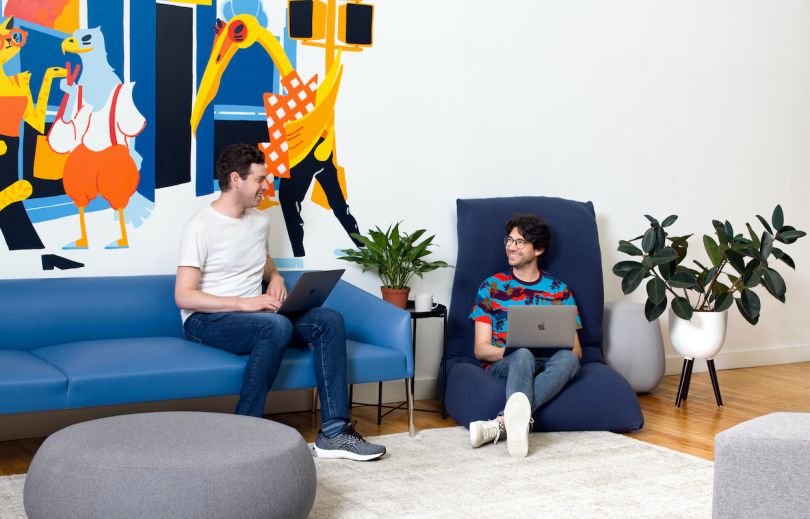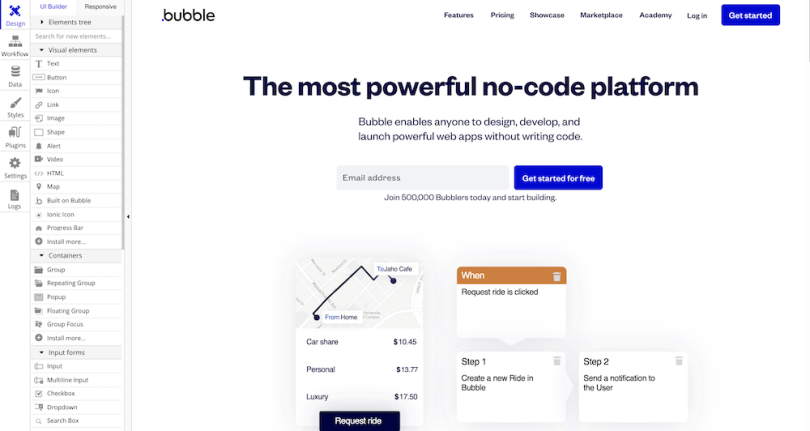
NYC-based Bubble announced Tuesday that it raised a whopping $100 million Series A, joining the growing number of web and app development startups riding the no-code wave. The round was led by global VC giant Insight Partners, with participation from notable angel investors including the founders of Datadog, Peloton and Hootsuite.
Bubble was one of the earliest no-code tools on the market. Founded by veteran software developers Emmanuel Straschnov and Josh Haas in 2012, it allows users to build any website or app they want without a single line of code. The cloud-based platform is visual, comprising only drag-and-drop tools, and has no templates, which means each site is created from scratch and completely unique. There are also hundreds of plug-ins that allow users to easily integrate tools like Stripe and Google Analytics in order to run their business once the site is built.
Straschnov says it typically takes users a few hours to learn how to use Bubble, then just a couple weeks to master it — a much shallower learning curve than learning to write code. And in the end, he claims Bubble is able to create a website or app that looks and feels the way any other website or app would, without the need for engineers or custom code.
Not only is this tool convenient, it can also save businesses hundreds of thousands of dollars a year in labor costs. A subscription is about $29 a month, a relative steal when you consider the average salary for a software engineer in NYC, so Bubble is an enticing solution for cost-conscious startups. Today, Bubble is used by lots of successful early stage companies, including personal finance app Qoins and job search platform Teal.

No-code and low-code platforms like Bubble have certainly been having a moment lately. Companies like Squarespace, Unqork and Airtable have pulled in massive funding rounds over the last year amid surging demand. Meanwhile, Bubble has been around for nearly a decade, quietly bootstrapping and perfecting the product so that it would be “good enough to have exponential growth,” as Straschnov put it. The company raised its first round of funding in 2019, and since then it has grown “very quickly.”
“I think people have realized that learning how to code is not the way to go. Which, now, sounds obvious, but in 2015 it was not,” Straschnov said. “But I think after a few years, people have realized that it’s a very complicated investment for people, and it doesn’t necessarily get to the right place in terms of actual skill set.”
Then, of course, there’s the pandemic. With all that extra time inside, people wanted to learn new skills and pursue new ventures, Straschnov explained, but they didn’t want to spend the time and money necessary to learn code and program something by hand. So they turned to tools like Bubble, causing the company’s revenue to triple in the last 12 months.
Now, Bubble plans to grow even more with the help of this fresh funding. Impressively, the company has managed to come this far with a slim team of just 15 engineers, and Straschnov says he would like to see the team reach 40 to 50 people by the end of this year, then double that by the end of next year.
Bubble also plans to heavily invest in its education side, partnering with universities and other organizations to help people learn how to use its platform. The company currently has a free pre-accelerator program for founders of color as well, and Straschnov added that the company would like to continue to do similar work. The goal, he says, is to “make technology more inclusive to everyone.”
“I think computer literacy and the ability to create technology is one of the big gaps in the world right now, so we started the company to solve that,” Straschnov said. “I think we have an opportunity to completely change how people build technology. Make it more inclusive and empower way more people to build things. That’s something that I really hope to take ’til the end. It’s a long journey ahead of us — probably another 10 years — but if we get to that point I think we’ll have built one of the most impactful new technologies in the world.”



